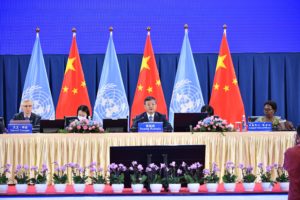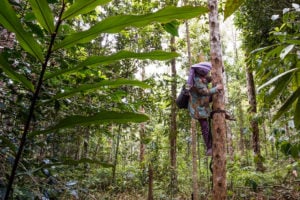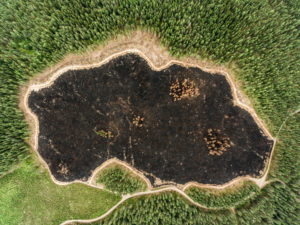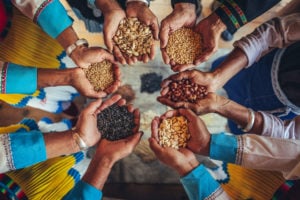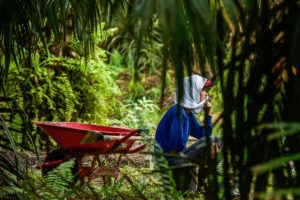The first session of the most important global biodiversity meeting in a decade was held in Kunming between 11 and 15 October, in an in-person and online hybrid format.
The 15th Conference of the Parties (COP15) to the UN Convention on Biological Diversity (CBD) launched a new stage in talks towards a global deal for nature – known as the post-2020 global biodiversity framework. China, as host nation, is ushering the CBD towards a roadmap for biodiversity conservation for the coming decade and beyond. Delegates to the talks were in agreement: the Aichi targets set in 2010 have been missed, but Kunming cannot be allowed to fail.
The Covid-19 pandemic has hampered progress towards the post-2020 framework, with proceedings delayed or forced online. At meetings of two subsidiary bodies to the CBD in May and June, network issues excluded most African nations from online discussions, leading them to request some matters be renegotiated in January next year.
In Kunming last week, many developing nation delegates were cut off and unable to speak on time during a two-day high-level segment, again due to technical issues. This was another reminder of the unbalanced outcomes of global development.
The negotiators have only seven months left until the second and final part of the meeting, and no shortage of disagreements to resolve, particularly regarding financing and implementation. In the Kunming Declaration published last week, signatories summarised their intention to ensure “that biodiversity will be put on a path to recovery by 2030 at the latest”. But it remains unclear whether they will be able to.
Difficult issues
The aim of the first session of the meeting was to inject new political ambition, rather than to get into real negotiations. Delegates, therefore, restated their existing positions.
The idea of conserving 30% of the Earth’s land and seas by 2030 – known as the 30×30 target – has been a “star topic” in the COP15 process. It was mentioned frequently during the first session, after appearing in the first draft of the post-2020 global biodiversity framework that was published in July.
A 2019 assessment by IPBES (the Intergovernmental Science-Policy Platform on Biodiversity and Ecosystem Services) found that only 15% of global land and freshwater and 7% of sea areas are protected. Although some parties feel the 30% target is too radical, given current progress, the eye-catching figure still made its appearance in the draft framework – a rare display of ambition. However, not everyone agrees on what that 30% means.
First, 30% of what exactly? Of the world’s entire surface? Or must it be both 30% of the land and 30% of the ocean? Or would each country protect 30% of its territory? The draft as it stands is not clear, and the matter will need to be thrashed out over the negotiating table. Particularly controversial is the idea of protecting 30% of the ocean, which would drag in other multilateral processes. If issues surrounding protected areas on the high seas cannot be resolved under the UN Convention on the Law of the Sea (UNCLOS) framework, the goal would not be possible.
The second question is: what kind of 30%? Some countries worry that a focus on quantity over quality will result in the protection of areas of little conservation value, simply to make up the numbers. But how should quality targets be set? The draft framework does not say. Another issue is that, historically, reserves have too often worked by excluding human activity. The 30×30 goal would see the expansion of protected areas, and there are concerns this could harm the rights of indigenous peoples and local communities living in biodiverse regions. Some signatories and NGOs are therefore ambivalent or even opposed to the goal. Li Shuo, global policy advisor with Greenpeace East Asia, told China Dialogue that despite its inclusion in the draft, the issue will be decided only at the last minute, at the second session of the Kunming talks in the spring.
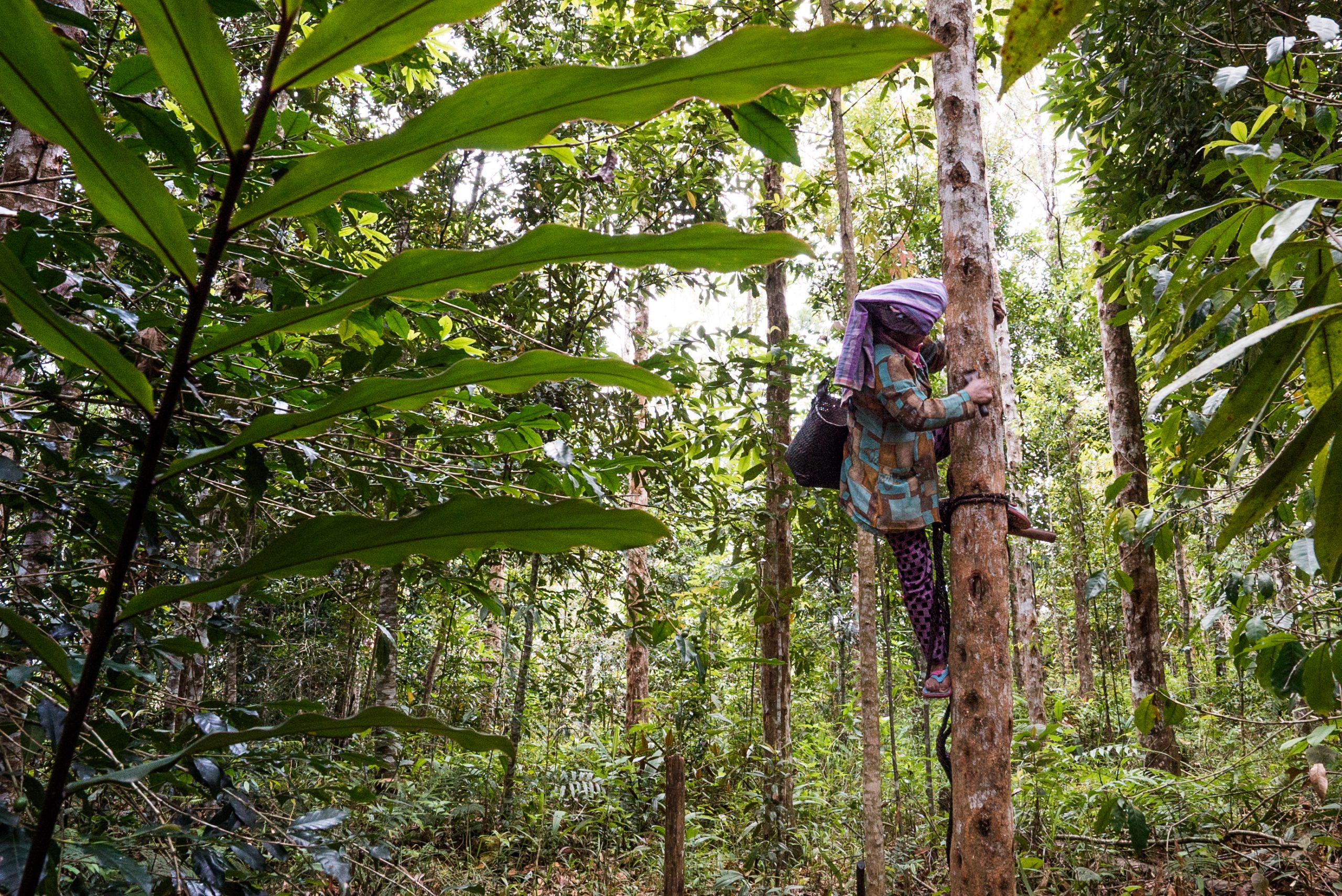
Alongside the 30×30 goal, other emerging ideas mentioned by delegates in their speeches are also proving hard for negotiators to tackle. Two of these are digital sequence information (DSI) and nature-based solutions (NbS).
DSI is information that has been obtained from sequencing and analysing genetic material. When the CBD was adopted back in 1992, Article 15 stated that a nation has sovereign rights over its genetic resources, and the authority to determine other countries’ access to them. Access must be on the basis of a nation’s prior and informed consent, with agreement on how the benefits are to be shared. When talks on this issue began in the 1990s the focus was on biological samples. By 2014, when the Nagoya Protocol on Access and Benefit Sharing of genetic resources came into effect to supplement the CBD, the digitalisation of genetic information was accelerating exponentially. But the potential commercial benefits of this digital information were not covered by benefit-sharing mechanisms.
Countries rich in genetic resources but lacking the capacity to utilise them want DSI to be covered by benefit-sharing mechanisms – a move opposed by countries strong in biotech. The two camps have not been able to narrow their differences. Developed nations say that open access should be a principle and that there are already many public databases of DSI. They say benefit-sharing mechanisms would reduce access to those, hampering innovation. Compliance with the Nagoya Protocol has reportedly delayed the sharing of influenza samples across national borders, impeding research and development for vaccines. The pandemic provided extra backing to the open access stance.
But given their current technological capacities, developing nations argue a benefit-sharing mechanism that doesn’t cover DSI would be of little value. During the Kunming talks last week, African delegates repeatedly stressed the importance of sharing benefits arising from use of the continent’s genetic resources and their DSI, and called for discussions on the issue to be finalised.
Since 2019, South Africa and Norway, the two countries most active on the issue of benefit sharing of DSI, have organised two rounds of talks discussing DSI issues and set up an informal “friends of the co-chairs” group to come up with proposals for negotiations.
The CBD’s progress has been too slow. The contrast between China’s ambitious domestic agenda and its modest diplomatic approach is striking. It’s time to bridge that gap.”Li Shuo, global policy advisor, Greenpeace East Asia
Another emerging concept is NbS, or nature-based solutions to climate and biodiversity challenges. These have received increasing attention since being included on a list of nine tracks of action at the 2019 UN Climate Action Summit. Supporters hope NbS can help tackle both climate change and biodiversity loss, as well as inject climate finance into the relatively underfunded area of biodiversity conservation. One example of NbS would be the restoration of coastal ecosystems such as mangrove swamps, increasing the provision of ecological services, while also absorbing carbon and mitigating the impact of the more frequent and severe storms caused by climate change.
NbS are important for both mitigation and adaptation to climate change, and many countries have been including these in their environmental planning for the last decade or more. Of the Nationally Determined Contributions (NDCs) to combatting climate change submitted by countries under the Paris Agreement, over 90% include NbS.
However, the position of NbS within the CBD framework is uncertain. Since 2000, the CBD has used the term “ecosystem-based approach” or EbA. An earlier draft (called the “zero draft”) of the post-2020 biodiversity framework published last year included the target to: “By 2030, increase contributions to climate change mitigation adaption and disaster risk reduction from nature-based solutions and ecosystems based approaches.” In the draft released this July, however, “nature-based solutions” had been removed.
The Kunming Declaration, passed by the conference on 13 October, also used the EbA term only, with a footnote explaining that “ecosystem-based approaches may also be referred to as ‘Nature based solutions’”.
So why the controversy? African nations and NGOs concerned about the rights of indigenous peoples worry there has been an emphasis on the carbon storage functions of NbS, with carbon emitters using tree-planting and other carbon offsets in developing countries to avoid their duties to cut emissions, while expropriating the forest usage rights of indigenous people and local residents. Some describe NbS as “carbon colonialism”.
At the closing ceremony for the COP15 high-level segment, the Third World Network, one of the NGO delegates, said: “Nature-based solutions are not synonymous with the ecosystem approach that complies with the sustainability obligations under the CBD. Accepting this contested term in decisions of the CBD without clear definition is like writing a blank cheque.” For them, it is crucial to explain “whose nature is being asked to solve which problems”.
However, the declaration also emphasises that “such ecosystem-based approaches do not replace the priority actions needed to urgently reduce greenhouse gas emissions in a way that is consistent with the goals of the Paris Agreement”.
Financing and implementation
Almost every speaker at Kunming talked of the need for ambition. But ambition comes with a price tag.
The draft framework points out an annual US$700 billion financing gap. Where will that money come from? Everyone is happy to talk of expanding sources of funding, leveraging non-state players and in particular the private sector, but developing nations are clear they want to see more money coming from the governments of developed nations – as that is the most reliable source of funding.
At the closing ceremony, the African Group again stressed the need for a dedicated biodiversity fund, as well as the importance of technology transfers and capacity building to allow for the use of bioresources and their DSI. The Latin America and the Caribbean Group warned that two years of the pandemic had resulted in an unprecedented shortage of funds, making it hard to fulfil obligations. Obtaining and making full use of adequate funding has always been a challenge for the CBD and its supplementary agreements in the region. “A real commitment to provide resources is one of the main amendments that need to be made if we want to halt and reverse the current biodiversity crisis,” the group says.
The EU and other developed nations stuck firmly to their existing stance: more private funds need to be mobilised, and aid funds must not flow towards harmful subsidies. Last year, the Paulson Institute and other international organisations published a report on biodiversity financing, finding that redirecting agricultural, forestry and fishing subsidies which harm biodiversity, in addition to improving supply chain sustainability, would free up nearly $300 billion. “But that is not acceptable to many developing nations – in particular, the ending of subsidies for small-scale farmers,” said Coraline Goron, assistant professor of environmental policy at Duke Kunshan University, speaking to China Dialogue.

On the second day of the Kunming talks, China’s president, Xi Jinping, announced 1.5 billion yuan ($230 million) in funding for biodiversity conservation in the developing world, and called for others to contribute. Japan responded with a $17 million extension to its own biodiversity fund, set up when it hosted COP10 in 2010. At the closing ceremony, the UK pledged £200,000 ($274,000) of extra funding for the CBD’s special voluntary trust fund. Observers were disappointed no other new funding commitments were made.
French president, Emanuel Macron, committed 30% of the country’s climate funding to biodiversity, and the UK said a large part of its extra climate funding would be spent on biodiversity. But this is simply a reallocation of climate change funds, rather than new money.
Talks on how to implement the CBD were also closely watched. Implementation problems were largely to blame for the failure to reach the Aichi targets, and so delegates to Kunming called for improvements. The EU called for an “effective monitoring framework” to ensure targets are met. Coraline Goron explained that the EU wants national commitments to follow the format of the framework’s global targets, and to see a system set up to record those commitments. That would allow the gap between the sum of national targets and the global target to be calculated. “But many signatories aren’t in agreement,” she said.
The speeches made by developing world representatives at the closing ceremony were more concerned with funding, technology transfers and capacity building than implementation.
But two weeks before the first session, China signalled its support for stronger implementation mechanisms. On 27 September, China and the EU held their 2nd High-Level Environment and Climate Dialogue, between China’s vice premier, Han Zheng, and Frans Timmermans, executive vice president of the European Commission. The two parties agreed to continue working together towards an ambitious, realistic and balanced post-2020 global biodiversity framework, “with clear and where feasible, measurable goals and targets and appropriate mechanisms for monitoring, reporting and review, as well as strong provisions for implementation and planning, and means to support implementation.”
Dimitri de Boer, head of ClientEarth’s China Office and team leader of the China–EU Environmental Project, thinks that is an encouraging signal. He said that, unlike the climate convention, the CBD lacks convenient mechanisms to track collective ambitions, or to regularly take stock of progress. “Clear systems of common indicators, monitoring, reporting and review, and global stocktaking of progress and ratcheting of ambitions, are all urgently needed to reverse biodiversity loss.” He added: “This is the first time a Chinese leader has explicitly supported the need for this.”
China’s Kunming offer
China’s role as host meant other higher expectations for it. At a press conference marking the end of the first stage of COP15, a German reporter asked Huang Runqiu, chair of the conference and China’s environment minister, if China wanted to see the 30×30 goal written into the framework. Huang did not give a definite answer, but indicated that as host, China would work to achieve consensus and produce ambitious and realistic goals.
De Boer said: “I believe China’s hesitation in formally supporting this target is mainly because China doesn’t want to alienate certain developing countries which may not yet be ready to embrace that target. However, this isn’t holding China back from acting domestically.”
Coraline Goron said that, given the complexity of the situation, perhaps all China can do is make its own highly ambitious commitments, showing leadership as it has on climate change.
Li Shuo said: “So far the CBD’s progress has been too slow. Autopilot won’t get us there. The contrast between China’s ambitious domestic agenda and its modest diplomatic approach is striking. It’s time to bridge that gap.”
China has also been promoting global biodiversity governance outside of the CBD process, for example in bilateral partnerships. During the China–EU High-Level Environment and Climate Dialogue, the two sides agreed to reduce global deforestation by bolstering cooperation on conservation and sustainable management of forests, supply chain sustainability and by combatting illegal logging and associated trading.
“This is the first time that one of China’s top leaders has explicitly emphasised this, and it is an extremely important step in the context of global action for biodiversity,” said de Boer. “One of the key drivers behind global biodiversity loss is the conversion of rainforest for the production of soft commodities such as soy, palm oil, beef, pulp and paper, and timber. Having this important point included in the communiqué gives me increased confidence that both China and Europe will quickly step up their efforts in this regard.”
According to de Boer, Xi Jinping is stressing the need to balance ambition and feasibility not so as to reduce ambition, but to enable a new agreement which all signatories, including developing nations, can embrace, with targets that will actually be achieved by 2030. “That would be the ultimate sign of success of the post-2020 global biodiversity framework,” he said.
